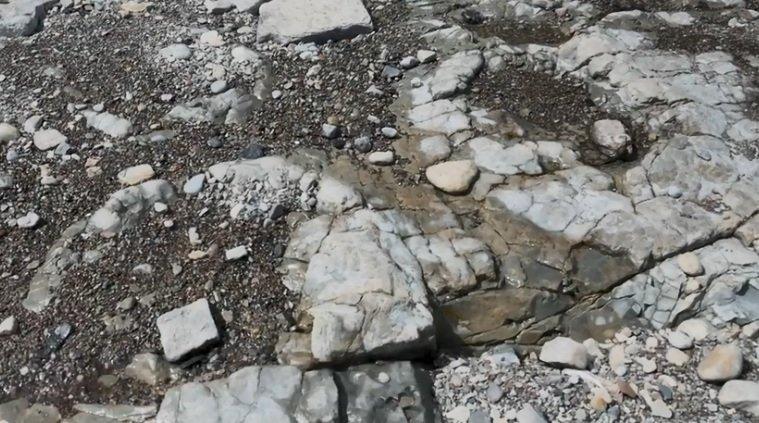Wales dinosaur footprints: 'Squelch marks' could prove they are real
- Published
- comments

These marks in the rock could be dinosaur footprints
It's not quite a Welsh dragon, but footprints from a dinosaur might have been discovered on a beach in Wales.
The possible footprints are imprinted on rock on the coast at Penarth, Vale of Glamorgan, and are thought to be the latest of several dinosaur discoveries in the area.
On the same section of coastline, fossilised remains from a distant cousin of the Tyrannosaurus rex were found in 2014.
The discoveries are now being looked at by experts to check if they are the real thing.
"if these are indeed dinosaur footprints it's going to be really, really exciting," said palaeontologist Cindy Howells, from the National Museum of Wales.
The 'footprints' have been found on the beach in Penarth
To work out if the marks in the rock are actual footprints, researchers will look at things such as how many marks there are and whether the pattern matches up to the steps a dinosaur would have made.
But finding out if they are genuine could depend on so-called "squelch marks".
"If you can't see the specific shape, quite often you'll look for other features, like the fact that you get one or two footprints in a left-right pattern," Howells said.
"You also look for the size and shape of these holes and you'll look for things like the rounded rims you've got on these, which we call 'squelch marks'. So as the animal is putting its feet into the clay, into the mud, the mud is rolling up around the foot.
"It's a very rare thing to find new footprints."
However, what makes this discovery more likely is that similar footprints have already been confirmed as genuine further down the coast, near Barry and Porthcawl.
"There are huge numbers of fossils," said geologist John Nudd, from the University of Manchester.
"Anywhere on the beach here you're bound to find bits of Jurassic rocks and you can't fail to find fossils. Every bit you look in almost has bits of fossils."
Dinosaur footprints like this one become fossilised and can be discovered millions of years later
How do dinosaur footprints become fossilised?
Even though dinosaurs walked the earth millions of years ago, their footprints were made in the same way as the animals of today; walking on soft ground, like mud.
Some dinosaur footprints were never washed away and were filled in with sand or small pebbles and eventually hardened into rock, a bit like a cast.
Having survived millions of years, the footprints can show up today as big chunks of rock in the shape of a dinosaur's foot. Other prints show up when some of the sand and pebbles that filled the print hole get washed away again to reveal its outline.
The Big Question: What's the difference between all the dinosaur periods?
'Wales was a busy area for dinosaurs at the time'
Prof Paul Barrett, who is researching the prints at the Natural History Museum in London, said Kerry Rees, who lives locally to the beach, discovered the potential dino tracks.
"Kerry sent the museum some pictures that had been uncovered following some very high tides and we decided that it would be interesting to check them out," he said.
"These are deep, round in outline and bear many of the hallmarks of dinosaur tracks, as they seem to be regularly spaced and have raised mud rims like those that form as a foot pushes into wet mud or sand."
The museum hopes to have an answer on whether the marks are dinosaur footprints soon.
Dr Susannah Maidment, who also works at London's National History Museum, said that if the tracks were confirmed, they would be among some of the oldest in the UK. The prints were most likely made in the Jurassic period around 145 to 200 million years ago.
"Other trackways of similar age, and one good dinosaur skeleton, have been found a few miles along the coast, near Barry, so south Wales was a busy area for dinosaurs at the time," she said.
- Published9 June 2015
- Published28 March 2019
